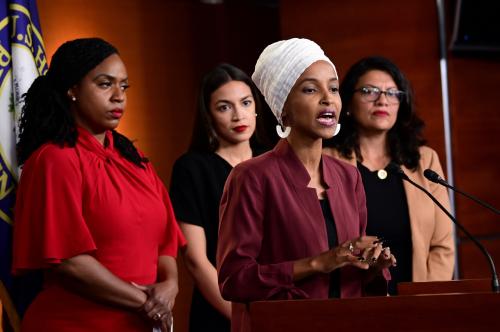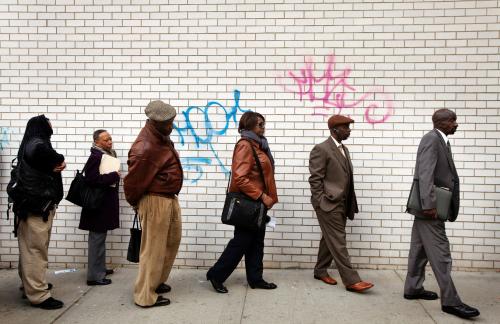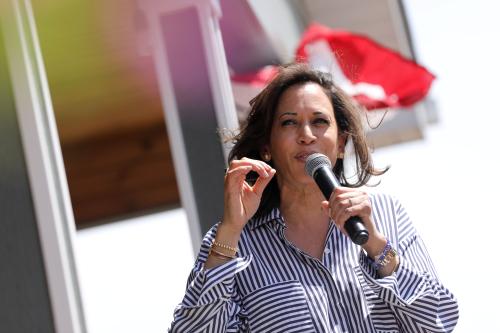Before President Trump boarded a plane to visit the sites of the mass shootings that occurred over the past weekend in Dayton, Ohio and El Paso, Texas, he responded to questions regarding the rise of hate groups.
“I am concerned about the rise of any group of hate,” Trump replied. “I don’t like it, any group of hate, whether its white supremacy, whether it’s any other kind of supremacy, whether its antifa… I am very concerned about it and I’ll do something about it.”
Trump’s attempt to equate white supremacy to anarchists, activists and other groups who are opposed to white nationalism, Nazism and other organizations that believe in racial hierarchies resonates with prior comments made in the aftermath of alt-right protests in Charlottesville, Va. in 2017. “We condemn in the strongest possible terms this egregious display of hatred, bigotry and violence on many sides,” Trump said. “On many sides.”
White supremacy has no equivalency in the United States.
A hierarchy of human values based on race was systemically codified into law, influencing the distribution of public and private goods that benefited whites while suppressing opportunities for other groups. Antifa did not deem black people three-fifths human in the Constitution. Supposedly radical left-wing hate groups did not tilt housing markets to facilitate wealth for white people while simultaneously denying black citizens similar opportunities. The radical left doesn’t have a long sordid history of terrorism including lynching, cross-burning, church bombings and mass shootings that explicitly sought to suppress black voting and our right to peaceful protest. A system of white supremacy did do all those things.
For instance, white residents have also tried to enforce segregation in response to federal policy. After Buchanan v. Warley outlawed racially based zoning in 1917, neighborhood associations took matters into their own hands. These groups created racially restricted covenants, private agreements that forbade homeowners from selling their homes to “a person not of the Caucasian race.”
Beginning in the 1930s, the Federal Housing Administration (FHA) openly refused to give home loans to black Americans. In a practice called redlining, the FHA’s maps graded the city’s neighborhoods, with red representing “hazardous” areas that were risky for lending. In reality, the red-lined neighborhoods were predominantly black; the classification had nothing to do with residents’ creditworthiness. Meanwhile, white residents had no problems acquiring FHA loans and building wealth through homeownership. Antifa was nowhere in sight.
White supremacy has no equivalency in the United States.
Although Congress passed the Fair Housing Act in 1968, de facto segregation persists. Black loan applicants continue to be denied in larger numbers than their white counterparts, even after controlling for factors like income and loan amount. The effects of housing policy under a system of white supremacy are apparent today. My research shows that in the average U.S. metropolitan area, homes in neighborhoods where the share of the population is at least 50% black are priced 23% less than in homes where the share of black people is less than a percent. This devaluation occurs after taking into consideration housing quality, size and neighborhood amenities like crime, education and walkability.
In addition, the President and his father, Fred Trump, have had no small hand in maintaining housing segregation. In 1973, the Justice Department sued Trump Management, the family’s New York City-based real estate business, for discriminating against blacks. Instead of settling, the vocal fight against the suit was “complete with angry denials, character assassination, charges that the government was trying to force him to rent to ‘welfare recipients’ and a $100 million countersuit accusing the Justice Department of defamation.”
Trump’s false equivalency is a crass cover up for a system of white supremacy that he benefited from. There is no “Antifa supremacy.” The “both sides” rhetoric is a refusal to accept responsibility for parroting racist language that was also used by terrorists. Trump in numerous speaking engagements and tweets described those seeking to cross the U.S.-Mexico border as “invaders.” The shooter in El Paso, Tex. spoke of a “Hispanic invasion.”
On the campaign trail, then candidate Trump, stated, “When Mexico sends its people, they’re not sending their best. They’re not sending you…They’re bring drugs; they are bringing crime; they’re rapists.” On Tree of Life Synagogue shooter Robert Bowers’ social media post, he wrote, “I have noticed a change in people saying ‘illegals’ that now say ‘invaders’,” read one post, six days before the shooting. “I like this.”
Trump’s false equivalency is a crass cover up for a system of white supremacy that he benefited from.
Two day before Bowers killed 11 in October 2018, Trump tweeted, “Sadly, it looks like Mexico’s Police and Military are unable to stop the Caravan heading to the Southern Border of the United States. Criminals and unknown Middle Easterners are mixed in. I have alerted Border Patrol and Military that this is a National Emergy (sic). Must change laws!”
There is no way for sure to know if those shooters responded directly to Trump. However, Trump’s rhetoric comes from the same poisoned well as white supremacists and mass shooters.
Yet the President continues to compare his sordid actions to incomparable people and groups. “As just came out, the Dayton situation, he [the Dayton shooter] was a fan of Antifa. He was a fan of Bernie Sanders and Elizabeth Warren – nothing to do with Trump,” Trump stated yesterday. “Both sides” bombast is an implausible political talking point that Trump supporters are using to not hold a president of the United States accountable. “Both sides” is inherently racist because it shields against what is ultimately responsible for the biased policies and practices that hurt people every day.
No, there are not two sides. There is public policy that has developed out of white supremacy that we should all be working against.
Allison Hardebeck provided excellent research assistance for this post.







Commentary
There are not ‘two sides’
August 8, 2019